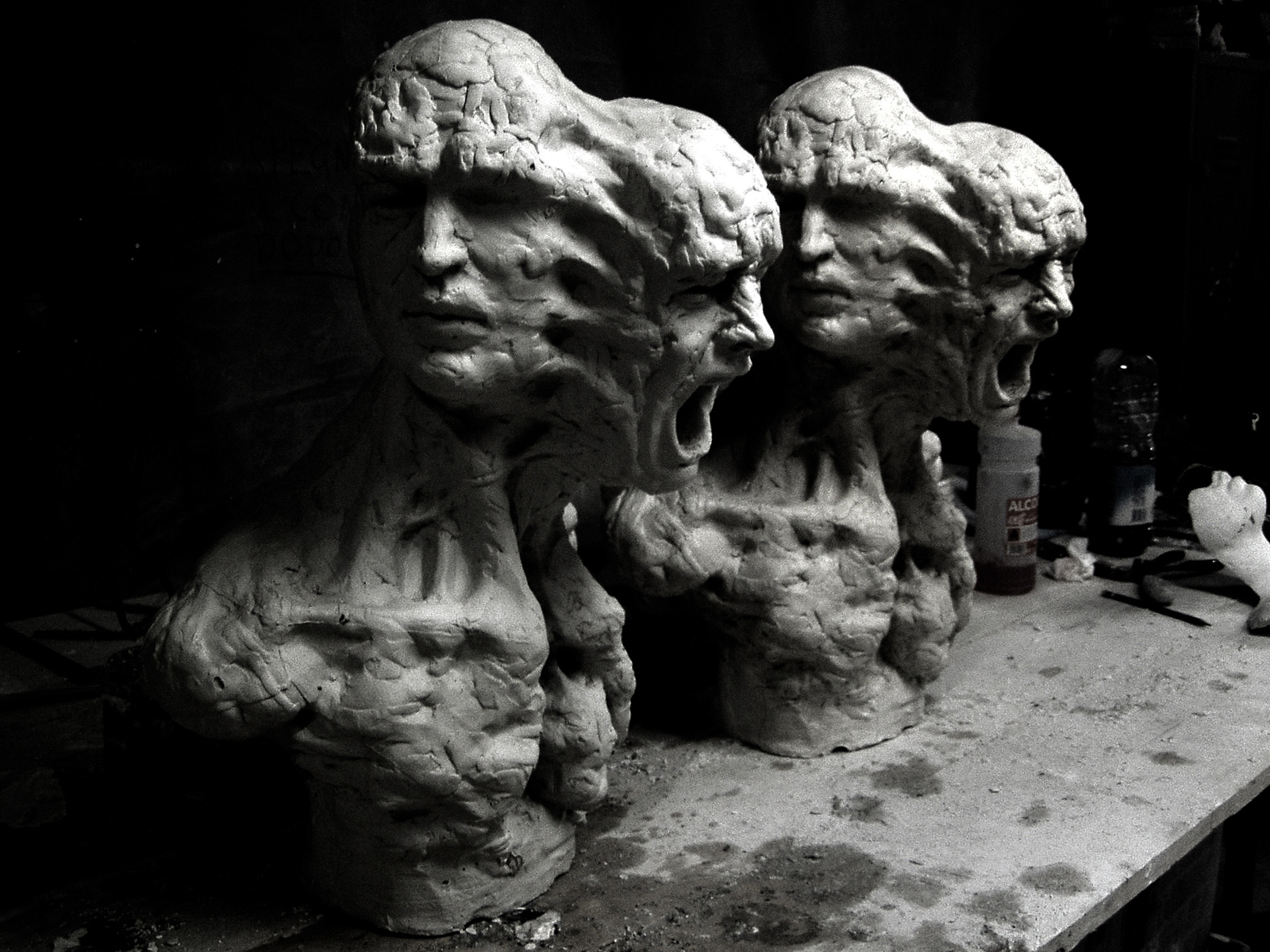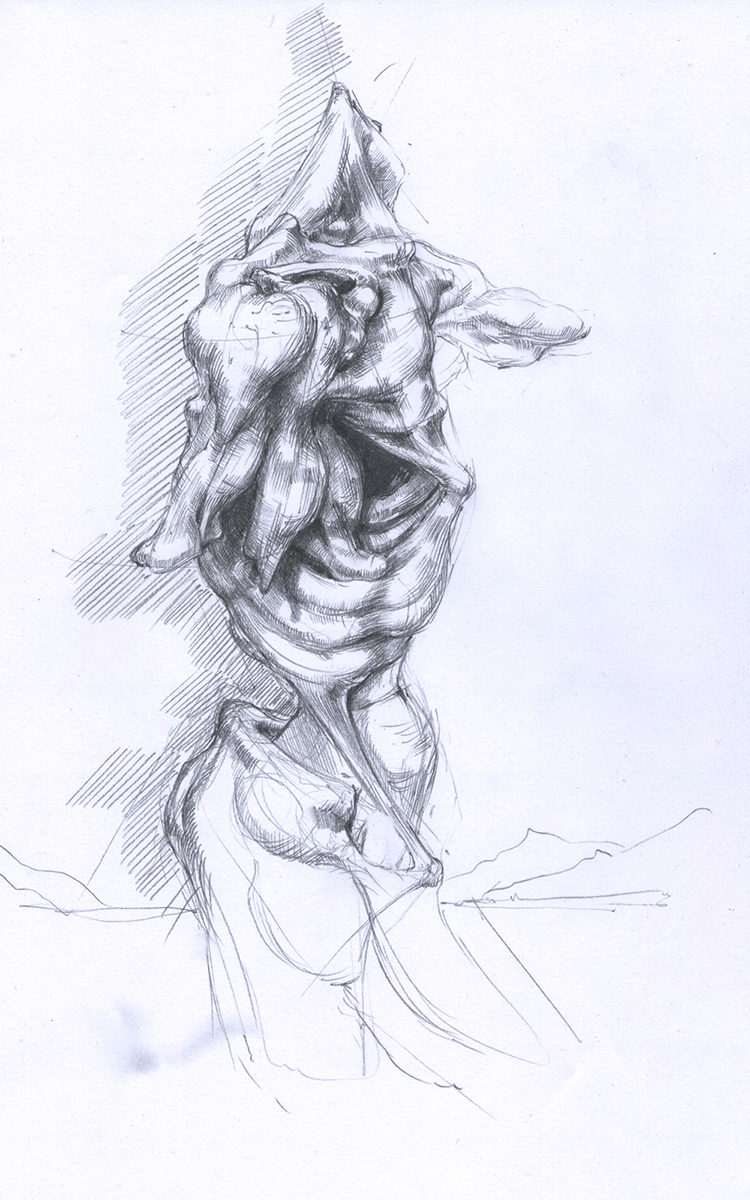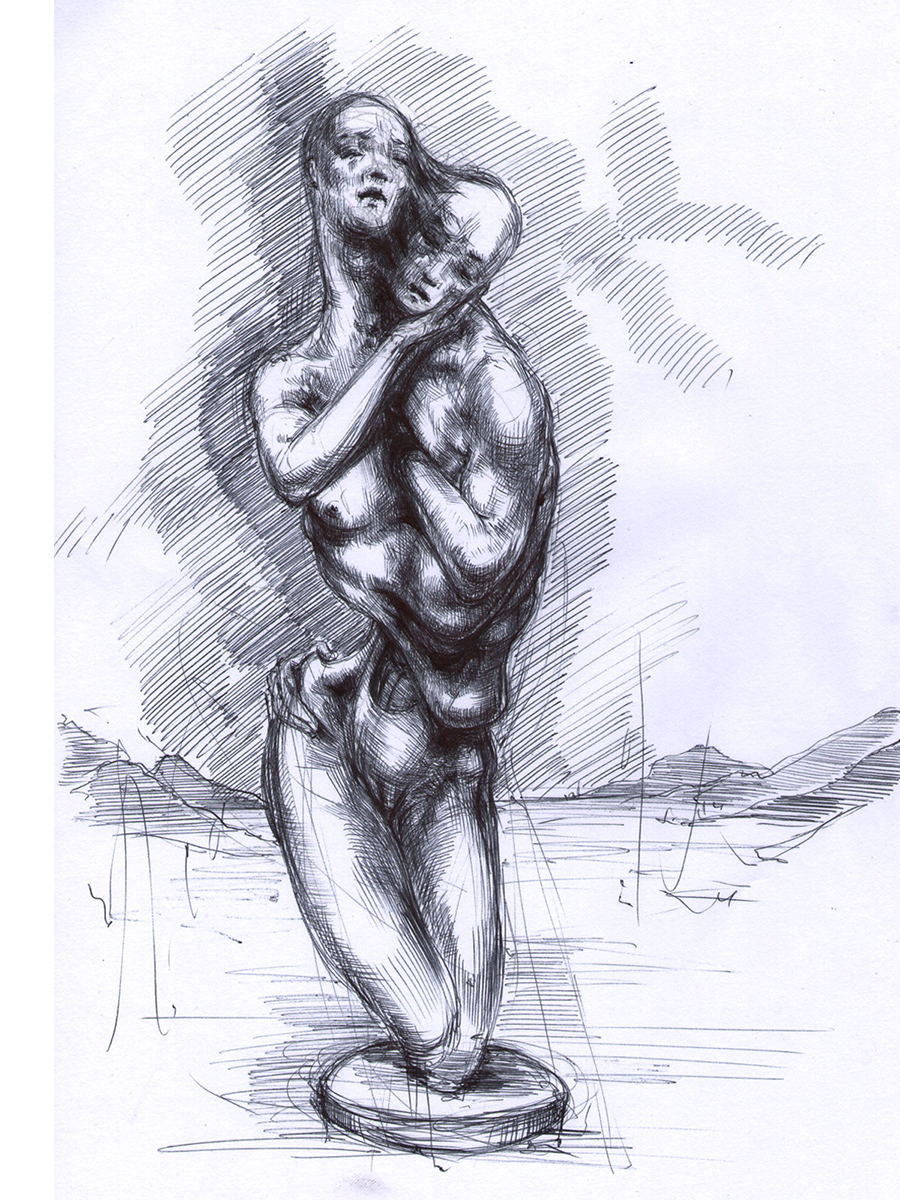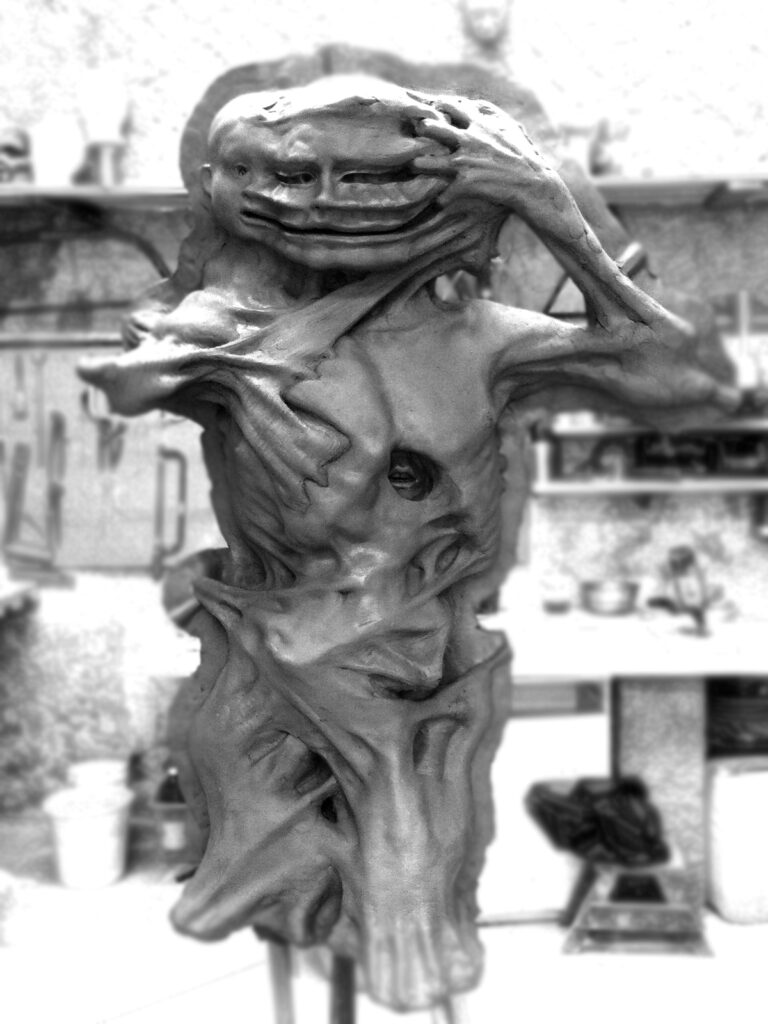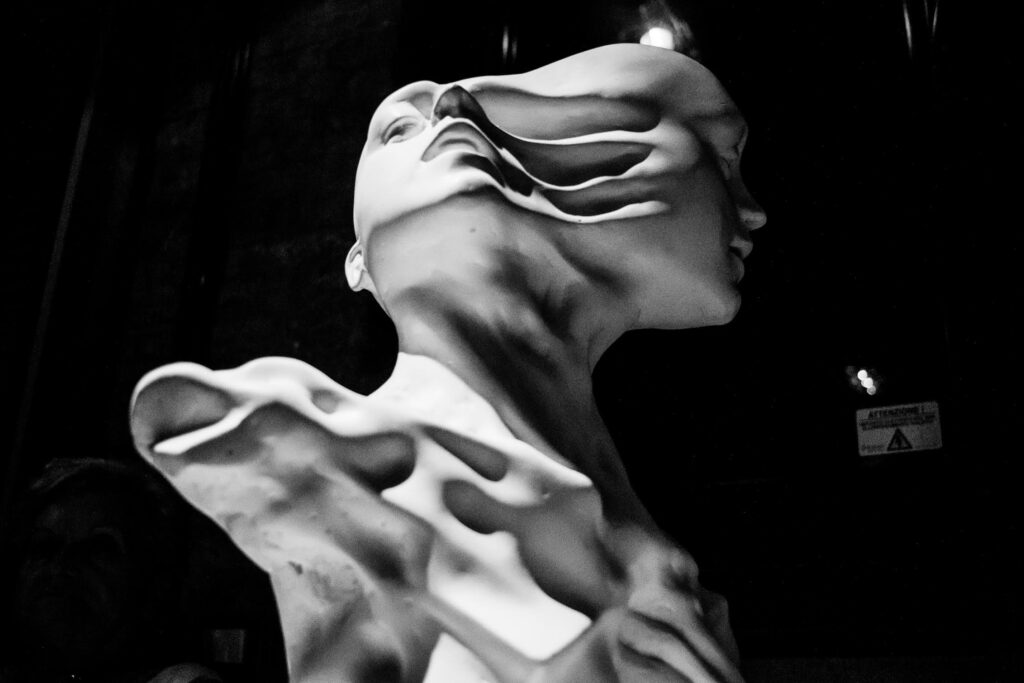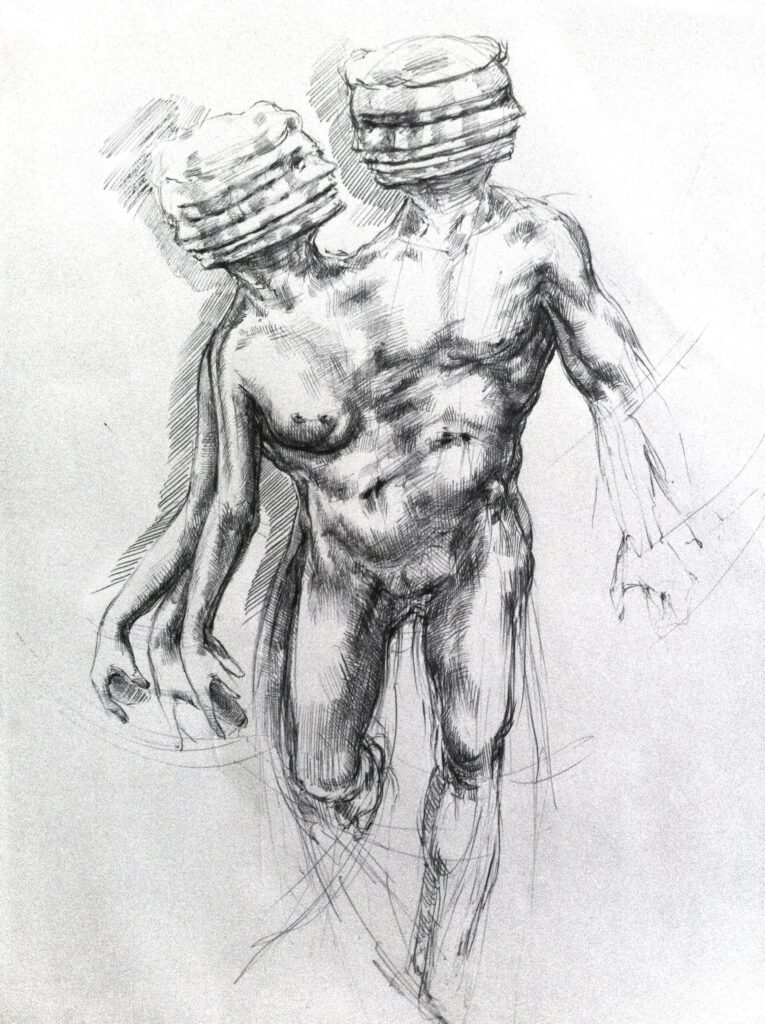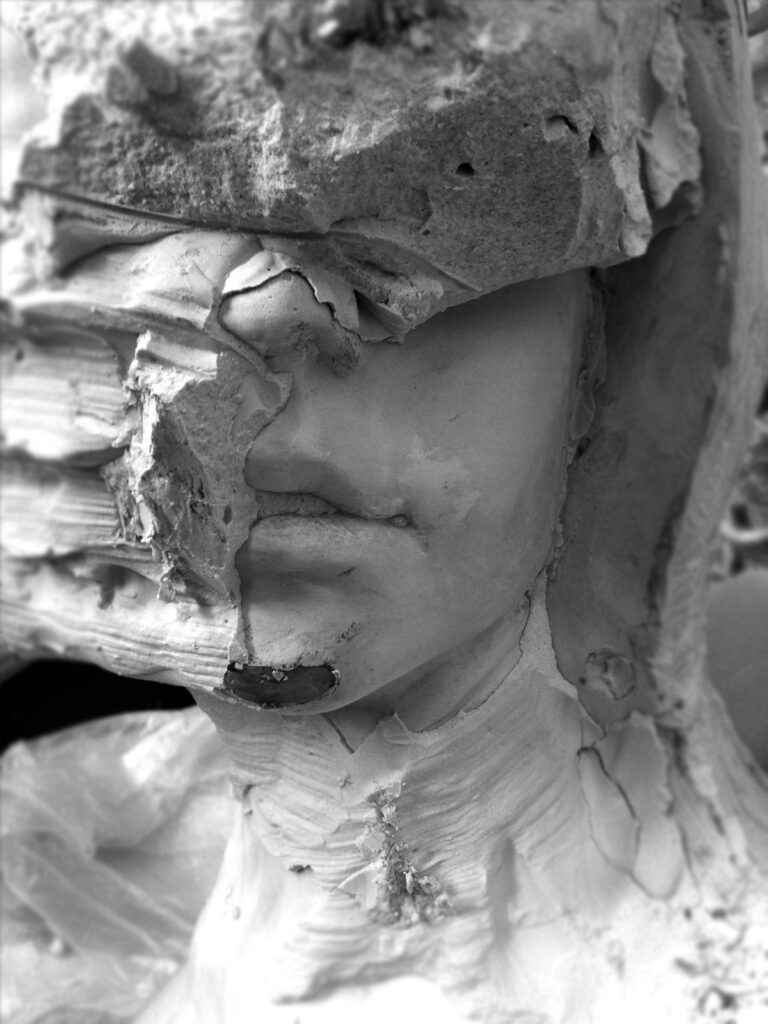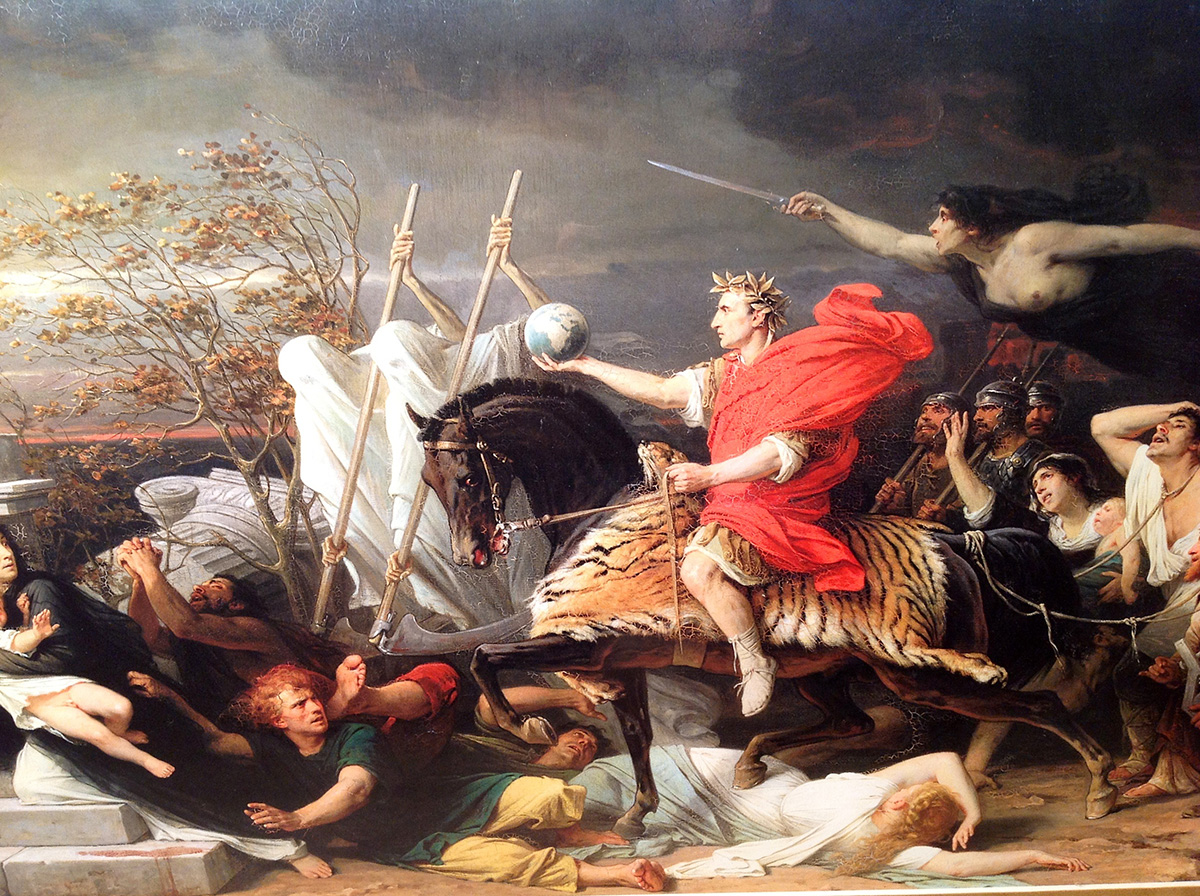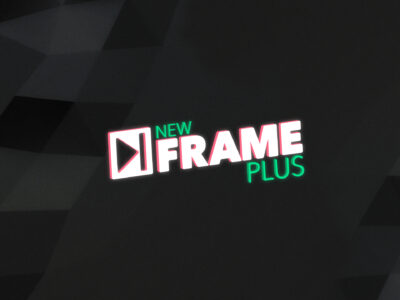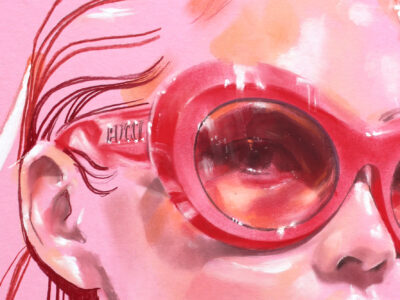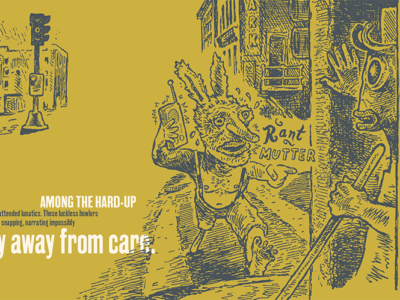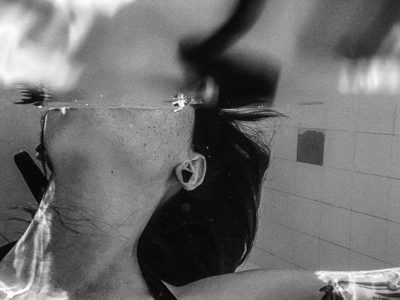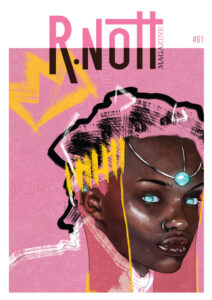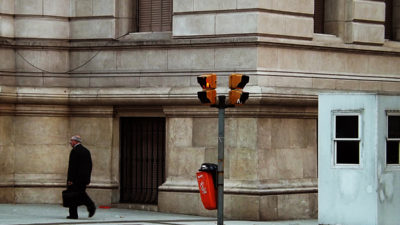Entrevistamos o escultor italiano Enrico Ferrarini, cujas obras nos transportam a um universo único de expressões, sentimentos, e movimentos, seja na rigidez do mármore ou na mobilidade da argila. Conheça sua formação e sua sensível trajetória.
“Meus personagens são uma combinação de história, tradição, contos da mitologia, contos bíblicos, emoções, expressões do corpo, expressões da face, expressões de sentimentos… Tudo traduzido numa forma presente que é filtrada pelo que sinto e pelas pessoas que tenho em volta de mim.”
♦ Como, onde, quando e por quê?
Tudo começou numa vila pequena do interior. Um lugar formado por horizontes vastos e planos, campos extensos de plantação e céus abertos. Uma região não só rica por seu espaço mas também por seu povo unido por um grande desejo de viver. Eu comecei cedo a trabalhar com a terra, nas fazendas durante o verão, e ao mesmo tempo com argila no Instituto de Arte A. Venturi, em Modena. Desenvolvi ali os primeiros estudos com cerâmica. Uma das minhas grandes sortes foi encontrar vários professores de artes bastante entusiastas e motivadores. Em particular o meu professor de desenho, Guiseppe Vicinelli, um homem que te mostrava como representar a realidade com um lápis enquanto te conta histórias épicas sobre a Bíblia, história, mitologia, natureza, ciência, arquitetura, educação, literatura… Como se o desenho em si mesmo fosse uma forma de contemplação de tudo o que já foi criado.
Essa foi uma das primeiras pessoas que me fizeram acreditar na “mágica” da criação. Após os meus 18 anos eu decidi me mudar para Florença, e lá comecei a estudar na seção de Escultura da Academia de Belas Artes. Foram anos de trabalho e estudo onde eu encontrei muitas pessoas talentosas e escultores de todo o mundo. Era uma academia, na época, cheia de pessoas jovens, talentosas e doidas, e nos reuníamos muito para ajudar uns aos outros com os trabalhos, ou apenas em churrascos amigáveis. Depois aproveitei a oportunidade de assistir a um curso longo na Alemanha, na Akademie der Bildended Kunste Munchen, em Munique. Ali estudei e experimentei diferentes materiais e técnicas, mas nada tirava a minha atenção da argila. Então, assim que voltei a Florença eu preparei um novo trabalho, mais pessoal, para a minha dissertação. Terminados os estudos eu tentei imediatamente encontrar um trabalho que pudesse estar perto do que aprendi, e em mais um golpe de sorte, encontrei-o como professor em uma escola privada de arte, e trabalhei ali por dois anos. Depois de um temo senti de novo a necessidade de criar e voltar a me aproximar da escultura. Tirei um período para viver em Carrara, e por ali parei por mais dois anos. Durante esse tempo eu tive sorte de trabalhar em um workshop com o grande artista e professor Grzegorz Kowalski, primeiro em Carrara e depois na Varsóvia. Era um homem muito próximo à beleza da simplicidade e cheio de entusiasmo pela expressão e pelo diálogo. Foi outra pessoa me motivou muito a continuar. Em Carrara eu tirei a minha terceira graduação e aprendi como a beleza do molde pode ser transportada ao mármore. Finalmente retorno à Florença onde trabalho agora como professor. Em Carrara mantenho um estudo com outros quatro amigos e escultores, e trabalho ali em dias livres.
♦ Como você vê a arte da escultura hoje, e como acha que se encaixa nela.
Eu acho que a escultura hoje está se aproximando lentamente da beleza e importância da natureza e da figura. Minha esperança é que um dia a arte se aproxime mais da natureza, dos valores humanos e da expressividade, um tipo de nova renascença. Com o meu trabalho eu apenas tento dar minha contribuição, como professor e como escultor. Acho que a arte deve expressar se ligar à simplicidade e coragem em partilhar sentimentos, valores, e aos tempos em que vivemos hoje, juntos, aprendendo do passado para construir um novo futuro, sem importar que tipo de arte seja usado.
♦ Da sua cabeça aos seus materiais, qual é o seu processo criativo?
Meu processo criativo não segue uma única linha. Tudo começa com emoção e intuição. Os projetos variam um pouco entre a imaginação e a realidade. Com o desenho, posso perceber que o que quer que imaginemos pode assumir uma forma na realidade, mas tudo muda durante o trabalho, e nada é estabelecido com um projeto porque todo dia é diferente, todo dia você busca a sua intuição de que algo mudou, ou não. Por causa disso, na maioria das vezes eu nunca preparo um esboço antes, mas depois me acho estudando a escultura após tê-la iniciado.
♦ Com relação aos materiais, você trabalha com uma grande variedade. Quais são seus favoritos, e por quê?
Em primeiro lugar a argila. A argila é vida, é orgânica, como se desse vida ao que você criou com as mãos. É um material dinâmico, revigorado pela água e seco pelo calor, como as plantas. Um material que, embora seco, você pode sempre recuperar; mas para dá-lo força e durabilidade, deve-se cozinhá-lo em temperaturas muito altas, um tipo de ciclo de vida. Depois disso, o mármore. Mármore é a ressurreição, um material que contém vida, história e poeira de milhões de anos. Um material que subiu das profundzas da terra e que reflete a luz antes mesmo de ser perfurado. Eu acho isso muito, muito fascinante. Outros materiais são o gipso, que me permite parar a impressão da escultura na argila e traduzi-la ao mármore. Bronze, resina e madeira eu também uso, mas são apenas testes para entender múltiplas soluções.
♦ Desde o ‘Uomo che cammina’ até Orfeu e Adão: quem são seus personagens, e de que modo outras formas de arte se relacionam com o seu trabalho?
“Uomo che cammina” era um estudo e uma primeira aproximação ao tema do movimento, como já tratado por Rodin e Boccioni, e muitos outros. “Orfeo” é uma representação da mitologia a respeito de “Orfeo ed Euridice”, juntando algumas histórias a respeito de Orfeu, mas que pudessem ter acontecido até mesmo alguns dias atrás, revisitado hoje em dia. “Adamo”, por outro lado, é uma das minhas primeiras esculturas de figura, então pensei numa representação do corpo nascido do chão e dançando. Meus personagens são uma combinação de história, tradição, contos da mitologia, contos bíblicos, emoções, expressões do corpo, expressões da face, expressões de sentimentos… Tudo traduzido numa forma presente que é filtrada pelo que sinto e pelas pessoas que tenho em volta de mim. Esses personagens para mim são você, eu, ele, ela, eles, todos.
♦ Movimento e fragmentos parecem ser partes constantes das peças que você produz. Conte um pouco a respeito do seu estilo.
Eu não sei se chamar isso de “estilo” o faz “diferente” de outras coisas. Posso dizer que isso se iniciou desde a base, a figura e as esculturas dos Gregos; mas mais ainda da Renascença, estudando a anatomia do corpo e o retrato. Depois pensei que a escultura poderia expressar mais do que um corpo ou um retrato, e comecei a imaginar modos de expressar mais coisas, como Rodin, Claudelle, e também o modo como trabalharam alguns pintores, como Francisco Goya, Frida Khalo, Francis Bacon e outros. Tentei expressar nossos conflitos, paixões e expressões através de uma única escultura. Daí nasceu a primeira “ghosting”, quando sentimos diferentes emoções simultaneamente, e como seria representar isso em um único corpo. Acabei percebendo que tudo isso seria mais moldável ainda… E deixei a imaginação me levar, e com o tempo vieram alguns insights. Depois de uma longa pausa outros insights vieram, como: como deixá-las falar, e como mover algo que em si é silencioso e estático? Desses pensamentos nasceram esculturas que intitulei “Attimo”, “momento”, tentando “parar” em um momento, uma palavra, ou um movimento no tempo e no espaço. Em paralelo a esses projetos eu acompanhei estudos sobre pesquisas recentes em neurociência e neurônios espelho. E, graças à argila, tudo isso começou a tomar forma.
♦ Quais são seus projetos futuros?
Na verdade eu não posso responder essa pergunta de maneira satisfatória. Todo dia é diferente. Tudo muda. O que eu posso dizer é que hoje eu estou dedicado ao estudo da Percepção. Percepção do espaço e do tempo por nós mesmos e pelos outros, sempre com muita dedicação ao campo emocional, e também a algo que eu espero poder um dia representar de algum modo: empatia. Amanhã, quem sabe.
♦ Maiores influências e heróis?
Minha família, meus amigos, e muitas pessoas diferentes (devo ter aí uma longa lista) que eu tive a sorte de conhecer em anos: esses são meus heróis.
E também uma história incrível que me fez descobrir o que a imaginação pode fazer: “La Metamorfosi dell’asino d’oro” – “a metamorfose do Asno de Ouro”, por Apuleio.
♦ Alguma consideração final?
Viva e ame o seu dia e as pessoas à sua volta como se fosse seu último dia. Você pode fazer acontecer tudo o que imaginar.
ENGLISH VERSION
♦ How, where, when and why.
Everything is born in a small country village. A place characterized by flat and vast horizons, formed by extensive grounds planted with fruit and open skies. A country not only rich in space but also of people united by a great desire to live. I have started early to work with the earth, in the farms during the summer months, and at the same time working with clay at the Art Institute A. Venturi in Modena. The first studies i developed there with ceramic. One of my many fortunes was to find a lot of enthusiasts craft teachers and often motivating. In particular my drawing teacher, Giuseppe Vicinelli, while a man who showed you how to represent reality with a pencil meanwhile tells you epic stories about the Bible, history, mythology, nature, science, architecture, education, literature,… as if the drawing itself was a form of contemplation on everything and on the created. This was one of the first people who made me believe in the “magic” of creating. After eighteen years I decided to move in Florence, and there i began my studies at the Academy of Fine Arts Sculpture section. They were years of work and study where I meet many talented peoples and sculptors from all over the world. An academy at the time full of young talented and crazy peoples, often where we gathered to help each other with work and also sometimes in a friendly barbeques. Later I took the opportunity to attend a long-term study in Germany at the Akademie der Bildended Kunste Munchen in Monaco of Bavaria. There I study and experimented with different materials and techniques, but nothing was able to distract my attraction for the clay, then, just come back to Florence, prepared new and more personal work for my dissertation. After studying immediately I tried to find a job that could be close to what I had learned, and other great fortune, I found work as a teacher in a private art school and I worked there for two years. Then I began to feel again the need to create and to get closer to sculpture. I took a period to live in Carrara, and I stopped there for another two years. During this time I was lucky to working in a workshop whit a great artist and great teacher Grzegorz Kowalski firstable in Carrara and after in Warsaw, a man very close to the beauty of simplicity and full of enthusiasm for the expressiveness and dialogue, another person who motivated me a lot to go on. There in Carrara I also took my third degree and learned how the beauty of a molded one can be translate in marble. Finally I returned back to Florence where I currently work as a teacher, and in Carrara I taken a large study along with other four friends and sculptors, where i still work on free days.
♦ How do you see the art of sculpture today, and how do you think you fit in it.
I think the sculpture today is slowly drawing closer to the beauty and importance of nature and to the figure. My hope is that one day art will approaches more on nature, human values and expressiveness, a kind of new renaissance. Whit my work I just try to give my contribute both, as a teacher and as a sculptor. I believe that art should express and engage with simplicity and courage in sharing feelings, value and the times that together we live today, learning from the past to build a new future, no matter what kind of art is applied.
♦ From your head to your materials, what is your process of creating?
My creative process does not have a common thread. It all starts with an emotion or intuition. The projects vary a little between imagination and reality. With the drawing, I can recognize that whatever we imagine can take shape in reality, but everything changes during working, nothing is established with a project because every day is different, every day you meet or sense that something has changed or not. For this mostly of the times i never prepare a sketch before, but I find myself studying the sculpture after the beginning.
♦ About materials, you work with a great variety. What are your favorites, and why?
First of all the clay. Clay is life, is organic, it’s like as if it gave life to what you create with your hands. A dynamic material, water invigorates and the heat fades, like plants. A material that although dry, you can always recover; but to give him strength and durability you have to cook it with very high temperatures, a kind of life cycle. Subsequently, the Marble. Marble is the resurrection, is a material which contains life, history and dust of millions of years ago. A material that has risen from the depths of the earth and reflects light before leaving it penetrate. I find it really, really fascinating. Other materials are gypsum, which allows me to stop the imprint of the sculpture in clay and then translate it in marble. Bronze, resin and wood, I use to work with, but those are unintended tests for understand multiple solutions.
♦ From the ‘Uomo che cammina’ to Orfeo and Adam: who are your characters, and how do other forms of art relate to your work?
“Uomo che cammina” was a study and first approach to the theme of the movement, as addressed by Rodin and Boccioni and many others. “Orfeo” is the representation of the mythology about “Orfeo ed Euridice”, collecting in the stories of Orpheus, but it could well be that happened a few days ago, revisited today. “Adamo” is instead one of my first sculptures of figure, so I thought about the representation of the body born from the ground and dancing with. My characters are a combination of history, tradition, mythological stories, biblical stories, emotions, expressions of the body, expression of the face, expression of feelings.. all translated into a present form filtered by what I feel and by the people I have around me. Those characters for me are you, me, he, she, they… everyone.
♦ Movement and fragments seem to be a constant part of the pieces you produce. Tell us some more about your style.
I do not know if calling “style” can make it “different” than others. I can say that is initially started from the base, the figure and sculptures from Greeks but mainly from the Renaissance, beginning to study the anatomy of the body and the portrait. Later I thought that the sculpture could express more than a body or a portrait, I began to imagine how to express more, like Rodin, Claudelle, and some painters as Francisco Goya, Frida Khalo, Francis Bacon and others have done with painting. Try to express our riots, our passions and expressions through a unique sculpture. From here were born the first “ghosting”, when we feel different emotions simultaneously and how to represent them in a single body. Then I thought that all this was even more moldable … and i let that imagination transport me, and some insights have come with time. After a long pause other insights came, like: how to let talk and how to move something that is itself silent and static? From these thoughts were born sculptures that I titled “Attimo” “moment”. Trying to “stop” at a time a word or a movement in time and space. Alternatively these projects I accompanied studies about recent research in neuroscience and mirror neurons. And thanks to clay, all began to take shape.
♦ What are your future projects?
Honestly I can’t give an answer that satisfy the question. Every day is different. Everything changes. What i can say is that at today I’m dedicated about the study of Perception. Perception of space and time by ourselves and others, always with a lot of dedication to the emotional field, and what I hope one day to be able to somehow represent: empathy. Tomorrow, who knows.
♦ Greatest influences and heroes?
My family, my friends, and many different peoples (I might have a long list) who I had the good fortune to meet in years: they are my heroes.
And an incredible story that made me realize what the imagination can do: “La Metamorfosi dell’asino d’oro” – “the metamorphosis of the Golden’s donkey”, by Apuleyo.
♦ Final words?
Live and love your day and the peoples around you as it’s your last day, everything you can imagine you can make it happen.


